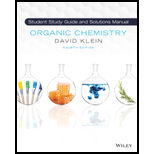
EBK ORGANIC CHEMISTRY-STUD.SOLNS.MAN+SG
4th Edition
ISBN: 9781119659525
Author: Klein
Publisher: WILEY CONS
expand_more
expand_more
format_list_bulleted
Concept explainers
Question
Chapter 7.3, Problem 6ATS
Interpretation Introduction
Interpretation: The synthesis of Aldingenin C involves the conversion of the compound to 2 via the intramolecular

Concept introduction:
A molecule can have both nucleophilic and electrophilic centers. An electrophilic center must be electron-deficient and can form a bond with a nucleophile. Here the nucleophile is an electron-rich species that can react with cation or any other electrophile. The
Expert Solution & Answer
Want to see the full answer?
Check out a sample textbook solution
Students have asked these similar questions
Synthesize N-Methylcyclohexylamine from cyclohexanol using the necessary organic or inorganic reagents. Draw the structures of the compounds.
If possible, please provide the formula of the compound 3,3-dimethylbut-2-enal.
Synthesize 1,4-dibromobenzene from acetanilide (N-phenylacetamide) using the necessary organic or inorganic reagents. Draw the structures of the compounds.
Chapter 7 Solutions
EBK ORGANIC CHEMISTRY-STUD.SOLNS.MAN+SG
Ch. 7.2 - Prob. 1CCCh. 7.3 - Prob. 2CCCh. 7.3 - Prob. 1LTSCh. 7.3 - Prob. 3PTSCh. 7.3 - Prob. 4ATSCh. 7.3 - Prob. 2LTSCh. 7.3 - Prob. 5PTSCh. 7.3 - Prob. 6ATSCh. 7.3 - Prob. 7CCCh. 7.4 - Prob. 8CC
Ch. 7.5 - Prob. 9CCCh. 7.6 - Prob. 10CCCh. 7.6 - Prob. 11CCCh. 7.7 - Prob. 12PTSCh. 7.7 - Prob. 13PTSCh. 7.7 - Prob. 14ATSCh. 7.7 - Prob. 4LTSCh. 7.7 - Prob. 16ATSCh. 7.7 - Prob. 17CCCh. 7.7 - Prob. 18CCCh. 7.7 - Prob. 5LTSCh. 7.7 - Prob. 19PTSCh. 7.7 - Prob. 20ATSCh. 7.8 - Prob. 21PTSCh. 7.8 - Prob. 22ATSCh. 7.8 - Prob. 23CCCh. 7.8 - Prob. 24CCCh. 7.8 - Prob. 25CCCh. 7.8 - Prob. 26CCCh. 7.8 - Prob. 27CCCh. 7.9 - Prob. 7LTSCh. 7.9 - Prob. 29ATSCh. 7.9 - Prob. 30ATSCh. 7.9 - Prob. 31ATSCh. 7.10 - Prob. 32CCCh. 7.10 - Prob. 33CCCh. 7.10 - Prob. 34CCCh. 7.11 - Prob. 8LTSCh. 7.11 - Prob. 35PTSCh. 7.11 - Prob. 36PTSCh. 7.11 - Prob. 37ATSCh. 7.11 - Prob. 9LTSCh. 7.11 - Prob. 40PTSCh. 7.11 - Prob. 41ATSCh. 7.12 - Prob. 42CCCh. 7.12 - Prob. 43CCCh. 7.12 - Prob. 44CCCh. 7.12 - Prob. 45CCCh. 7.12 - Prob. 46CCCh. 7 - Prob. 47PPCh. 7 - Prob. 48PPCh. 7 - Prob. 49PPCh. 7 - Prob. 50PPCh. 7 - Prob. 51PPCh. 7 - Prob. 52PPCh. 7 - Prob. 53PPCh. 7 - Prob. 54PPCh. 7 - Prob. 55PPCh. 7 - Prob. 56PPCh. 7 - Prob. 57PPCh. 7 - Prob. 58PPCh. 7 - Prob. 59PPCh. 7 - Prob. 60PPCh. 7 - Prob. 61PPCh. 7 - Prob. 64PPCh. 7 - Indicate whether you would use NaOEt or tBuOK to...Ch. 7 - Prob. 68PPCh. 7 - Draw a plausible mechanism for each of the...Ch. 7 - Prob. 70PPCh. 7 - Prob. 71PPCh. 7 - Prob. 72PPCh. 7 - Prob. 73PPCh. 7 - Prob. 74PPCh. 7 - Prob. 77PPCh. 7 - Prob. 78PPCh. 7 - Prob. 81ASPCh. 7 - Prob. 87ASPCh. 7 - Prob. 90ASPCh. 7 - Prob. 91IPCh. 7 - Prob. 92IPCh. 7 - Prob. 93IPCh. 7 - Prob. 94IPCh. 7 - Prob. 95IPCh. 7 - Prob. 96IPCh. 7 - Prob. 97IPCh. 7 - Prob. 98IPCh. 7 - Prob. 99IPCh. 7 - Prob. 100IPCh. 7 - Prob. 101IPCh. 7 - Prob. 102IPCh. 7 - Prob. 103IPCh. 7 - Prob. 105IPCh. 7 - Prob. 106IPCh. 7 - Prob. 107IPCh. 7 - Prob. 109IPCh. 7 - Prob. 110CPCh. 7 - Prob. 112CPCh. 7 - Prob. 114CP
Knowledge Booster
Learn more about
Need a deep-dive on the concept behind this application? Look no further. Learn more about this topic, chemistry and related others by exploring similar questions and additional content below.Similar questions
- Indicate the products obtained by mixing (3-oxo-3-phenylpropyl)triphenylphosphonium bromide with sodium hydride.arrow_forwardWe mix N-ethyl-2-hexanamine with excess methyl iodide and followed by heating with aqueous Ag2O. Indicate the major products obtained.arrow_forwardIndicate the products obtained by mixing acetophenone with iodine and NaOH.arrow_forward
- Indicate the products obtained by mixing 2-Propanone and ethyllithium and performing a subsequent acid hydrolysis.arrow_forwardIndicate the products obtained if (E)-2-butenal and 3-oxo-butanenitrile are mixed with sodium ethoxide in ethanol.arrow_forwardQuestion 3 (4 points), Draw a full arrow-pushing mechanism for the following reaction Please draw all structures clearly. Note that this intramolecular cyclization is analogous to the mechanism for halohydrin formation. COH Br + HBr Brarrow_forward
- Indicate the products obtained if 2,2-dimethylpropanal and acetaldehyde are mixed with sodium ethoxide in ethanol.arrow_forwardIndicate the products obtained if 2,2-dimethylpropanal and acetaldehyde are reacted with sodium ethoxide in ethanol.arrow_forward2,2-Dimethylpropanal and acetaldehyde are reacted with sodium ethoxide in ethanol. Indicate the products obtained.arrow_forward
- Add conditions above and below the arrow that turn the reactant below into the product below in a single transformationADS fint anditions 百 Abl res condinese NC ง Add on condtions 1.0 B H,N.arrow_forward3. Provide all the steps and reagents for this synthesis. OHarrow_forwardSteps and explanationarrow_forward
arrow_back_ios
SEE MORE QUESTIONS
arrow_forward_ios
Recommended textbooks for you

 Organic ChemistryChemistryISBN:9781305580350Author:William H. Brown, Brent L. Iverson, Eric Anslyn, Christopher S. FootePublisher:Cengage Learning
Organic ChemistryChemistryISBN:9781305580350Author:William H. Brown, Brent L. Iverson, Eric Anslyn, Christopher S. FootePublisher:Cengage Learning


Organic Chemistry
Chemistry
ISBN:9781305580350
Author:William H. Brown, Brent L. Iverson, Eric Anslyn, Christopher S. Foote
Publisher:Cengage Learning